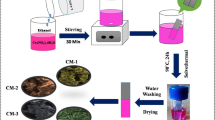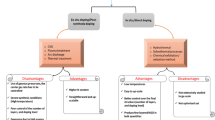Abstract
In recent years, graphene quantum dots with unique physiochemical properties have received considerable research attention in many fields. In this report, as a novel approach toward improving the capacitance value of MoS2 electrode, GQDs-MoS2 nanocomposite thin film was synthesized through one-step hydrothermal process. The microstructure and surface morphology of both MoS2 and GQDs-MoS2 nanocomposite thin films were characterized by X-ray diffraction, Raman spectroscopy, field emission-scanning electron microscopy, and Fourier transform infrared spectroscopy. The electrochemical performances of MoS2 and GQDs-MoS2 nanocomposite thin films was thoroughly compared via Autolab potentiostat–galvanostat with the three-electrode system. The results indicated that GQDs-MoS2 nanocomposite thin film demonstrates enhanced specific capacitance of 380 F g−1 under the current density of 0.6 A g−1. Moreover, the MoS2-GQDs thin film exhibited the highest energy density of 38.47 Wh kg−1 at the Current density of 0.6 A g−1.
Graphic abstract









Similar content being viewed by others
References
Jang BZ et al (2011) Graphene surface-enabled lithium ion-exchanging cells: next-generation high-power energy storage devices. Nano Lett 11(9):3785–3791
Zhao X et al (2011) The role of nanomaterials in redox-based supercapacitors for next generation energy storage devices. Nanoscale 3(3):839–855
Arico AS et al (2005) Nanostructured materials for advanced energy conversion and storage devices. Nat Mater 4(5):366–377
Guan C, Wang J (2016) Recent development of advanced electrode materials by atomic layer deposition for electrochemical energy storage. Adv Sci 3(10):1500405
Liu C et al (2010) Advanced materials for energy storage. Adv Mater 22(8):E28–E62
Liu J et al (2018) Advanced energy storage devices: basic principles, analytical methods, and rational materials design. Adv Sci 5(1):1700322
Han S et al (2014) Porous graphene materials for advanced electrochemical energy storage and conversion devices. Adv Mater 26(6):849–864
Chang X et al (2018) Efficient synthesis of tungsten oxide hydrate-based nanocomposites for applications in bifunctional electrochromic-energy storage devices. Nanotechnology 29(18):185707
Gao MR et al (2013) Nanostructured metal chalcogenides: synthesis, modification, and applications in energy conversion and storage devices. Chem Soc Rev 42(7):2986–3017
Wei D et al (2012) Graphene from electrochemical exfoliation and its direct applications in enhanced energy storage devices. Chem Commun 48(9):1239–1241
Lee H et al (2018) Enhanced electrochemical performance of carbon nanotube with nitrogen and iron using liquid phase plasma process for supercapacitor applications. Int J Mol Sci 19(12):3830
Xia H, Xu Q, Zhang J (2018) Recent progress on two-dimensional nanoflake ensembles for energy storage applications. Nanomicro Lett 10(4):66
Hu X et al (2019) An advanced NiCoFeO/polyaniline composite for high-performance supercapacitor. Chem Asian J 14(7):977–985
Lim E et al (2014) Advanced hybrid supercapacitor based on a mesoporous niobium pentoxide/carbon as high-performance anode. ACS Nano 8(9):8968–8978
Moussa M et al (2016) Recent progress and performance evaluation for polyaniline/graphene nanocomposites as supercapacitor electrodes. Nanotechnology 27(44):442001
Zuo W et al (2017) Battery-supercapacitor hybrid devices: recent progress and future prospects. Adv Sci 4(7):1600539
Mohammed AA, Chen C, Zhu Z (2019) Low-cost, high-performance supercapacitor based on activated carbon electrode materials derived from baobab fruit shells. J Colloid Interface Sci 538:308–319
Wang G, Zhang L, Zhang J (2012) A review of electrode materials for electrochemical supercapacitors. Chem Soc Rev 41(2):797–828
Galhena DTL et al (2018) Reduced graphene oxide as a monolithic multifunctional conductive binder for activated carbon supercapacitors. ACS Omega 3(8):9246–9255
Li Q et al (2018) Recent progress in some amorphous materials for supercapacitors. Small 14(28):e1800426
Li Q et al (2019) All hierarchical core-shell heterostructures as novel binder-free electrode materials for ultrahigh-energy-density wearable asymmetric supercapacitors. Adv Sci 6(2):1801379
Naderi L, Shahrokhian S (2019) Nickel molybdate nanorods supported on three-dimensional, porous nickel film coated on copper wire as an advanced binder-free electrode for flexible wire-type asymmetric micro-supercapacitors with enhanced electrochemical performances. J Colloid Interface Sci 542:325–338
Shi Y et al (2018) Stretchable and self-healing integrated all-gel-state supercapacitors enabled by a notch-insensitive supramolecular hydrogel electrolyte. ACS Appl Mater Interfaces 10(42):36028–36036
Muller GA et al (2015) High performance pseudocapacitor based on 2D layered metal chalcogenide nanocrystals. Nano Lett 15(3):1911–1917
Zhang X et al (2011) High-power and high-energy-density flexible pseudocapacitor electrodes made from porous CuO nanobelts and single-walled carbon nanotubes. ACS Nano 5(3):2013–2019
Sheberla D et al (2017) Conductive MOF electrodes for stable supercapacitors with high areal capacitance. Nat Mater 16:220–224
Wang Y, Xia Y (2013) Recent progress in supercapacitors: from materials design to system construction. Adv Mater 25(37):5336–5342
Zhang LL, Zhao XS (2009) Carbon-based materials as supercapacitor electrodes. Chem Soc Rev 38(9):2520–2531
Zhou Y et al (2016) In-situ fabrication of graphene oxide hybrid Ni-based metal-organic framework (Ni-MOFs@GO) with ultrahigh capacitance as electrochemical pseudocapacitor materials. ACS Appl Mater Interfaces 8(42):28904–28916
Li X, Zhu H (2015) Two-dimensional MoS2: properties, preparation, and applications. J Mater 1(1):33–44
Zhu H et al (2015) When cubic cobalt sulfide meets layered molybdenum disulfide: a core-shell system toward synergetic electrocatalytic water splitting. Adv Mater 27(32):4752–4759
Abbasi P et al (2017) Tailoring the edge structure of molybdenum disulfide toward electrocatalytic reduction of carbon dioxide. ACS Nano 11(1):453–460
Zhu G et al (2016) Tuning thermal conductivity in molybdenum disulfide by electrochemical intercalation. Nat Commun 7:13211
Winchester A et al (2014) Electrochemical characterization of liquid phase exfoliated two-dimensional layers of molybdenum disulfide. ACS Appl Mater Interfaces 6(3):2125–2130
Acerce M, Akdogan EK, Chhowalla M (2017) Metallic molybdenum disulfide nanosheet-based electrochemical actuators. Nature 549(7672):370–373
Alrasheed A et al (2018) Surface properties of laser-treated molybdenum disulfide nanosheets for optoelectronic applications. ACS Appl Mater Interfaces 10(21):18104–18112
Asadi M et al (2016) Cathode based on molybdenum disulfide nanoflakes for lithium-oxygen batteries. ACS Nano 10(2):2167–2175
Bilgin I et al (2015) Chemical vapor deposition synthesized atomically thin molybdenum disulfide with optoelectronic-grade crystalline quality. ACS Nano 9(9):8822–8832
Zhou F et al (2014) Carbon nanofibers decorated with molybdenum disulfide nanosheets: synergistic lithium storage and enhanced electrochemical performance. Angew Chem Int Ed Engl 53(43):11552–11556
Han P, Chung SH, Manthiram A (2018) Thin-layered molybdenum disulfide nanoparticles as an effective polysulfide mediator in lithium-sulfur batteries. ACS Appl Mater Interfaces 10(27):23122–23130
Ge Y et al (2018) Towards thermally stable high performance lithium-ion batteries: the combination of a phosphonium cation ionic liquid and a 3D porous molybdenum disulfide/graphene electrode. Chem Commun 54(42):5338–5341
Benson J et al (2015) Electrocatalytic hydrogen evolution reaction on edges of a few layer molybdenum disulfide nanodots. ACS Appl Mater Interfaces 7(25):14113–14122
Chen IP et al (2016) Large-scale fabrication of a flexible, highly conductive composite paper based on molybdenum disulfide-Pt nanoparticle-single-walled carbon nanotubes for efficient hydrogen production. Chem Commun 53(2):380–383
Bai LZ et al (2018) Synthesis and electrochemical performance of molybdenum disulfide-reduced graphene oxide-polyaniline ternary composites for supercapacitors. Front Chem 6:218
Acerce M, Voiry D, Chhowalla M (2015) Metallic 1T phase MoS2 nanosheets as supercapacitor electrode materials. Nat Nanotechnol 10(4):313–318
Clerici F et al (2016) In situ MoS2 decoration of laser-induced graphene as flexible supercapacitor electrodes. ACS Appl Mater Interfaces 8(16):10459–10465
Mandal D, Routh P, Nandi AK (2018) Quantum-dot-mediated controlled synthesis of dual oxides of molybdenum from MoS2: quantification of supercapacitor efficacy. Chem Asian J 13(24):3871–3884
Wang R et al (2017) Elucidating the intercalation pseudocapacitance mechanism of mos2-carbon monolayer interoverlapped superstructure: toward high-performance sodium-ion-based hybrid supercapacitor. ACS Appl Mater Interfaces 9(38):32745–32755
Zheng S et al (2018) MoS2 nanosheet arrays rooted on hollow rgo spheres as bifunctional hydrogen evolution catalyst and supercapacitor electrode. Nanomicro Lett 10(4):62
Yang W et al (2017) Carbon-MEMS-based alternating stacked MoS2@rGO-CNT micro-supercapacitor with high capacitance and energy density. Small 13(26):1700639
Liao X et al (2018) MoS2/MnO2 heterostructured nanodevices for electrochemical energy storage. Nano Res 11(4):2083–2092
Ma CB et al (2015) A general solid-state synthesis of chemically-doped fluorescent graphene quantum dots for bioimaging and optoelectronic applications. Nanoscale 7(22):10162–10169
Wang J et al (2016) Synthesis, photoluminescence and bio-targeting applications of blue graphene quantum dots. J Nanosci Nanotechnol 16(4):3457–3467
Yan Y et al (2018) Systematic bandgap engineering of graphene quantum dots and applications for photocatalytic water splitting and CO2 reduction. ACS Nano 12(4):3523–3532
Zheng P, Wu N (2017) Fluorescence and sensing applications of graphene oxide and graphene quantum dots: a review. Chem Asian J 12(18):2343–2353
Zheng XT et al (2015) Glowing graphene quantum dots and carbon dots: properties, syntheses, and biological applications. Small 11(14):1620–1636
Zhu S et al (2011) Strongly green-photoluminescent graphene quantum dots for bioimaging applications. Chem Commun 47(24):6858–6860
Islam MS et al (2016) In-situ direct grafting of graphene quantum dots onto carbon fibre by low temperature chemical synthesis for high performance flexible fabric supercapacitor. Mater Today Commun 10:112–119
Zhang S et al (2018) High-performance supercapacitor of graphene quantum dots with uniform sizes. ACS Appl Mater Interfaces 10(15):12983–12991
Zhang J et al (2018) Enhanced performance of planar perovskite solar cell by graphene quantum dot modification. ACS Sustain Chem Eng 6(7):8631–8640
Park J et al (2016) Graphene quantum dots: structural integrity and oxygen functional groups for high sulfur/sulfide utilization in lithium sulfur batteries. NPG Asia Mater 8:e272
Jia H et al (2018) Heterostructural graphene quantum Dot/MnO2 nanosheets toward high-potential window electrodes for high-performance supercapacitors. Adv Sci 5(5):1700887
Mondal S, Rana U, Malik S (2015) Graphene quantum dot-doped polyaniline nanofiber as high performance supercapacitor electrode materials. Chem Commun 51(62):12365–12368
Huang Y et al (2019) Graphene quantum dots-induced morphological changes in CuCo2S4 nanocomposites for supercapacitor electrodes with enhanced performance. Appl Surf Sci 463:498–503
Chang K, Chen W (2011) In situ synthesis of MoS2/graphene nanosheet composites with extraordinarily high electrochemical performance for lithium ion batteries. Chem Commun 47(14):4252–4254
Dong YS, Shao J, Chen C, Li H, Wang R, Chi Y, Chen G (2012) Blue luminescent graphene quantum dots and graphene oxide prepared by tuning the carbonization degree of citric acid. Carbon 50(12):4738–4743
Liu W et al (2013) Novel and high-performance asymmetric micro-supercapacitors based on graphene quantum dots and polyaniline nanofibers. Nanoscale 5(13):6053–6062
Saraf M, Natarajan K, Mobin SM (2018) Emerging robust heterostructure of MoS2–RGO for high-performance supercapacitors. ACS Appl Mater Interfaces 10(19):16588–16595
Yang X et al (2016) A high energy density all-solid-state asymmetric supercapacitor based on MoS2/graphene nanosheets and MnO2/graphene hybrid electrodes. J Mater Chem A 4(29):11264–11275
Thangappan R et al (2016) Graphene decorated with MoS2 nanosheets: a synergetic energy storage composite electrode for supercapacitor applications. Dalton Trans 45(6):2637–2646
Author information
Authors and Affiliations
Corresponding author
Additional information
Publisher's Note
Springer Nature remains neutral with regard to jurisdictional claims in published maps and institutional affiliations.
Electronic supplementary material
Below is the link to the electronic supplementary material.
Rights and permissions
About this article
Cite this article
Moghimian, S., Sangpour, P. One-step hydrothermal synthesis of GQDs-MoS2 nanocomposite with enhanced supercapacitive performance. J Appl Electrochem 50, 71–79 (2020). https://doi.org/10.1007/s10800-019-01366-3
Received:
Accepted:
Published:
Issue Date:
DOI: https://doi.org/10.1007/s10800-019-01366-3




